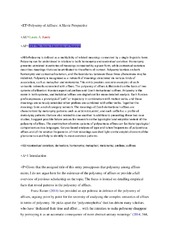Polysemy of affixes: A Slavic Perspective
Author
Janda, Laura AlexisAbstract
Polysemy is defined as a multiplicity of related meanings connected by a single linguistic form. Polysemy can be understood in relation to both homonymy and contextual variation. Homonymy presents unrelated inventories of meanings connected by a given form, while contextual variation describes meanings that can be attributed to the effects of context. Polysemy borders on both homonymy and contextual variation, and the boundaries between these three phenomena may be indistinct. Polysemy is recognized as a network of meanings structured via various kinds of association, such as metaphor and metonymy. This entry provides concrete examples of such semantic networks connected with affixes. Two systems of affixation illustrate the polysemy of affixes: Russian aspectual prefixes and Czech derivational suffixes. Polysemy is the norm in both systems, and individual affixes are singled out for more detailed analysis. Each Russian prefix expresses a prototypical ‘path’ or trajectory in combination with motion verbs, and these meanings are variously extended when prefixes are combined with other verbs. Together the meanings form a radial category network. The meanings of Czech derivational suffixes are characterized by metonymy patterns such as action for agent, and each suffix has a profile of metonymy patterns that are also related to one another. In addition to presenting these two case studies, I suggest possible future venues for research on the typological and empirical extent of the polysemy of affixes. The examination of entire systems of polysemous affixes can facilitate typological comparisons across languages. Corpus-based analyses of type and token frequencies of polysemous affixes and of the relative frequencies of their meanings can shed light on the empirical extent of the phenomenon and help to identify its most common patterns.
Publisher
WileyCitation
Janda LA: Polysemy of affixes: A Slavic Perspective. In: Ackema P, Bendjaballah, bonet e, Fabregas A. The Wiley Blackwell Companion to Morphology, 2023. John Wiley & SonsMetadata
Show full item recordCollections
Copyright 2023 The Author(s)


 English
English norsk
norsk